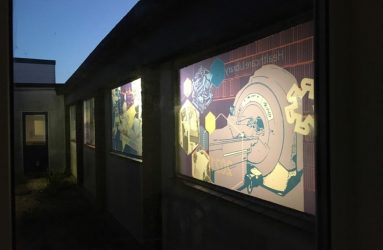
Windows into history
ArtCare have designed and installed a new set of window designs in the corridors leading to the new MRI-2 suite. These windows take their inspiration from images in our historical archives at Salisbury District Hospital. They tell of the changes through time of the buildings in this area. WW2 field hospital, early NHS kitchens and Healthcare Library were all housed in the space now occupied by MRI-2 suite.
1942 – War time origins
Inspired by a set of images taken by US personnel during WW2, when Odstock was 158th General, US Army Hospital. The main photograph, from John S Fandl, shows soldiers waiting for food and handwritten note states ‘We nonchalantly queue up at mess hall for typical “gourmet” dinner’. Present day Hedgerows coffee shop is on the site of the soldiers mess hall and the new MRI-2 suite occupies the building that was the kitchens. We also used the plan of the hospital which dates from 1942. This layout of the US Army WW2 field hospital shows the red brick single story buildings that still stand in much of the central and south areas of Salisbury District Hospital. The nissen huts (shown middle top) stood where the new ‘North’ hospital stands today. The hospital was deliberately designed to spread out, single story units, to minimise any damage that may occur during a bombing raid.
1948 – A little known fact
This window design celebrates and recognises the scientific innovation that took place at Salisbury hospital after WW2. The central photograph is a detail of an image in our archives. It shows the staff of the Pathology Department in 1941. Central amongst the group is Dr Edward Darmady (1906-1989) The first kidney dialysis machine was developed here at Salisbury by Dr Darmady. He was the Salisbury Infirmary Assistant Pathologist in the 1930s and RAF Squadron leader during WW2. In 1946 Dr Darmady experimented in constructing his own dialysing machine that was powered by recycled parts dismantled from WW2 spitfires (which had been built in Salisbury at secret workshops during the war). The background motifs are taken from the spitfire silhouette, medical equipment used during experiments and cross-section through kidney tubules.
1955 – Early years of the NHS from 1948 onwards
This window shows a nursing staff group posing for a photograph outside the buildings that are now part of the central corridors at Salisbury District Hospital. This was during the early years of the National Health Service that began in 1948 and the old army buildings became locally known as ‘Odstock Hospital’, formally ‘Salisbury General Hospital’ and present day ‘Salisbury District Hospital’ (since 1992). We also used an early map of the site in the design. You can see that the new ward names took inspiration from local villages. Nursing staff take a tea break and sit out in the sunshine on the grass outside buildings of the present day central corridors.
1980 – An army marches on its stomach and so does the NHS!
Here you can see the chef preparing fresh food to go out to the wards of Odstock Hospital. Through the window you can see the chimney of the hospital boiler house. These kitchens re-used the WW2 army facilities and were located on the site of the present day MRI-2 suite. The background design of the window uses the silhouette shapes of the kitchen and boiler room chimneys against the skyline of the hospital site. A Salisbury Journal newspaper article, in the archives, from 1975 records the installation of catering system allowing trays of food to be prepared for patients in kitchen and then delivered direct in heated trolleys to wards. The black and white shows this system in action in the 1980s.
2021 – A Christmas present like no other
This window shows an MRI scanner at Salisbury District Hospital being used for patient diagnosis. The background design of the window panel shows the Healthcare Library that stood on the site of MRI-2 between 2010 and 2020. The inset details record when Father Christmas and his elves delivered an extra special Christmas present on 20th December 2020. Instead of a sleigh, he drove a crane, delivering a brand new MRI-2 scanner through the roof into a new suite at Salisbury District Hospital. Funded by The Stars Appeal.
The window film is translucent so that during the day sunlight shines through to the corridor and lights up the bright colours of the designs. At night, from the new MRI-2 suite, you can see them illuminated by the artificial light in the corridors. The window film also allows privacy in the clinical areas from passing pedestrians in the main corridor areas. The corridor area is a busy, fairly industrial looking space, which is open directly to the outside weather. Therefore materials needed to be hard wearing and impervious to cold and damp climates in the winter and hot dry summers.

























